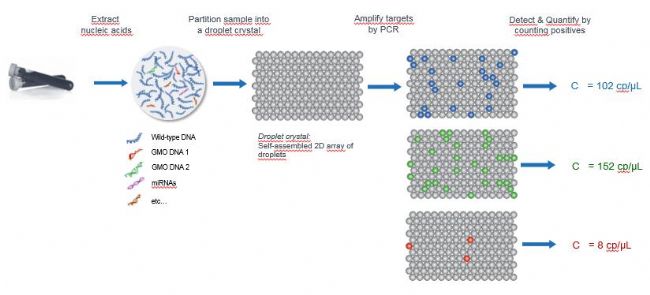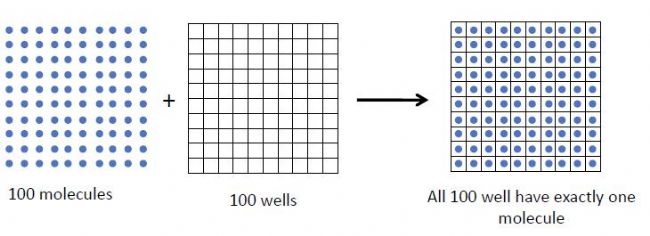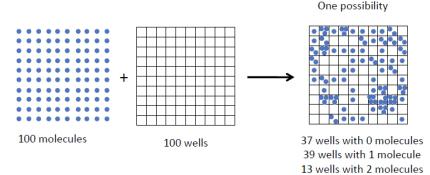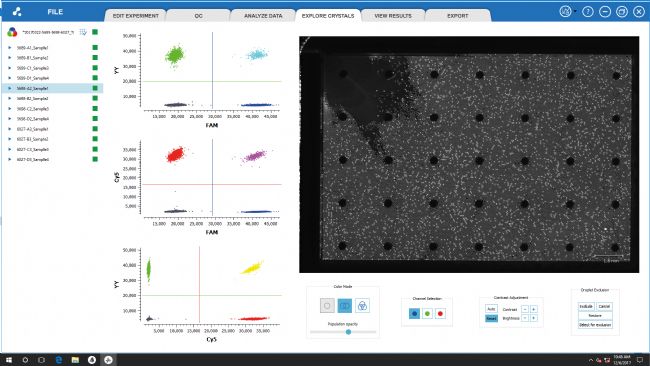Crystal digital PCR technology is an absolute quantification technology for nucleic acid molecules. The principle is to distribute the PCR reaction system into a large number of tiny reactors, with or without one or more copies of the target nucleic acid molecule in each microreactor. (DNA template), performing "single molecule template" PCR amplification. After the end of the amplification, the number of copies of the target gene in the original sample was calculated by the number of positive reaction units (determined by the endpoint fluorescent signal) and statistical methods. The workflow consists of four main steps, namely PCR/RT-PCR reaction premixing of sample DNA/RNA, dispersion or partitioning of reaction premix, PCR amplification, fluorescence signal acquisition and data analysis (as shown below). Crystal digital PCR disperses sample DNA into 25,000-300 million droplets, with or without one or more copies of the target molecule (DNA template) in each droplet, all droplets in a 2D array The layers were randomly tiled in a sapphire chip for PCR amplification. After the amplification, the negative or positive fluorescent signals of each reaction unit were read and statistically analyzed, and the template copy number of the original sample was calculated. So how do we guarantee that there is only one DNA molecule in each droplet? For example: Disperse 100 DNA molecules into 100 droplets. Ideally, we want 100 DNA molecules to be evenly distributed in 100 droplets as shown in Figure A below, but the actual situation is 100 DNA molecules. Random states are distributed in 100 droplets, as shown in Figure B below. A. Ideal distribution Figure: Average distribution of DNA molecules (ideal, A) and random distribution (actual case, B) As the target DNA molecules are randomly distributed in the positive reaction unit, the counting of the positive reaction units is performed directly, which is not the actual copy number of the target DNA molecule, and each reaction unit may contain two or more target molecules. The Poisson probability distribution formula (1) can be used for calculation. In the above formula (1), λ is the average copy number of the starting DNA molecules contained in each reaction unit, and p is a probability that k-copy target molecules are contained in each reaction unit under a certain λ condition. λ is determined by the dilution factor m (or number of partitions) of the sample solution, ie λ = cm, where c is the original copy number of the sample. When k=0, that is, when the target DNA molecule is not contained, p is the ratio of the number of reaction units without fluorescence signal to the total number of reaction units, that is, the ratio of the negative reaction unit, and the formula (1) can be simplified to the formula (2). : By the end point method, the number of total reaction units n and the number of positive reaction units having a fluorescent signal f can be obtained, so the ratio of the negative reaction units is the formula (3). So get the following equation: That is to say, when the absolute quantification of the nucleic acid is carried out by the digital PCR method, the average nucleic acid copy number of the reaction unit can be determined only by the ratio of the negative reaction unit and the dilution coefficient (or the number of partitions) of the sample, thereby realizing accurate quantification of the DNA. This is how digital PCR technology achieves the absolute quantification of nucleic acids. The premise of Poisson distribution application and digital PCR result correction is that the events need to be uniform, including the volume of the droplets, geometric parameters, and PCR reaction conditions. Crystal digital PCR realizes the uniformity of the droplets and the consistent reaction conditions by automating the microdrop array. At the same time, the software automatically controls the geometric parameters of the droplets and traces them to a single droplet to give the most reliable. Data results. Fire Alarm By Kitchen,Fire Alarm Of Kitchen,Fire Smoke Alarm Of Kitchen,Fire Smoke Alarm Kitchen Guangdong Isafenest Co.,Ltd. , https://www.isfenest.com
 B. Random distribution under actual conditions
B. Random distribution under actual conditions 
 (1)
(1)  (2)
(2)  (3)
(3)  (4)
(4)
For both sides of the above formula, taking the logarithm of e as the base, the following equation is obtained:  (5)
(5)  Microdropping single point source
Microdropping single point source